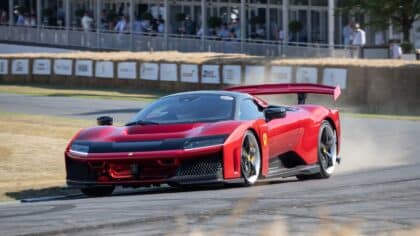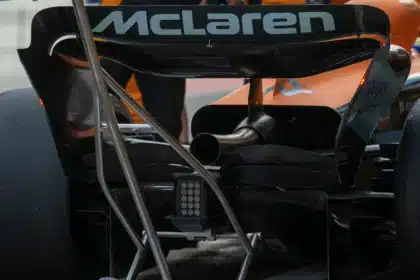 Photo: Lukas Raich via CC
Photo: Lukas Raich via CC
It’s official: Honda will return to Formula 1 in 2026 as the exclusive engine manufacturer for the Aston Martin Racing team. Honda had left the sport at the end of 2021 after a change in its management, but new 2026 F1 engine regulations focusing on sustainability enticed the automotive giant to come back.
“One of the key reasons for our decision to take up the new challenge in F1 is that the world’s pinnacle form of racing is striving to become a sustainable racing series, which is in line with the direction Honda is aiming toward carbon neutrality, and it will become a platform which will facilitate the development of our electrification technologies,” said Honda CEO Toshihiro Mibe.
Pit Stop: How to tell if your car needs new tires
Honda has a pattern of entering and exiting the sport, and its new stint starting in 2026 will be its fifth. While it had a major run of success in the 80s, its recent history in F1 has been a rollercoaster. It joined forces with McLaren in 2015, but due to a variety of factors, its engines were both slow and unreliable. Honda steadily improved through 2016, but seemed to go back to square one in the following year, and McLaren moved on to different suppliers after that.
At the time, McLaren had thrown Honda under the bus at just about every opportunity, even producing an Amazon propaganda-documentary to tell viewers, “Don’t worry, we’re still good, it’s Honda that’s holding us back.” Since then, McLaren’s stubborn inability to succeed with either Renault or Mercedes power units have shown it was likely overstating its chassis’s capabilities during the Honda era.
Meanwhile, the Red Bull Racing association struck a partnership with Honda, giving it time to develop with its sister team AlphaTauri (then called Toro Rosso) and shielding it from criticism in the media. The strategy clearly worked, as Honda eventually developed what became regarded as possibly the best engine on the F1 grid, and powered Red Bull’s Max Verstappen to a world championship win in 2021.
And that’s when it pulled out.
 Photo: Honda
Photo: Honda
The timing was perplexing, and Honda clearly had mixed feelings about the whole endeavor. Even before they had officially left, top Honda personnel were already saying they would probably be back. The official narrative was that F1 was not compatible with Honda’s long-term EV plans, but that’s usually the sort of decision executives make when the company isn’t at the top of the game.
And of course, it’s not as though Honda truly ever left. The automaker continued to operate behind the scenes, granting authorization to the newly-formed Red Bull Powertrains to use its engine IP, and providing the organization with the necessary personnel to continue developing and supporting its engine. As of 2022, it no longer says “Honda” on the Red Bull car, and yet it is a Honda engine that powered it to a double championship win that year, a feat that looks to be repeated in 2023.
In fact, thanks to an engine freeze, it will be Honda’s engine that Red Bull continues using all the way until Honda officially returns in 2026. The Japanese manufacturer could potentially power an F1 team to eight championship victories without receiving credit for any of them.
 Photo: Honda
Photo: Honda
Honda’s future alliance with Aston Martin Racing should be exciting to F1 fans hoping for more competition. The Aston Martin Racing project, which began in 2021 as a commercial rebranding of the former Racing Point team, has shown promise. Its car became notably more competitive at the end of 2022 and has been firmly in the fight for podiums so far in 2023.
Currently, Aston Martin’s powertrain components are supplied by rival team Mercedes. An exclusive relationship with Honda should give it an extra edge. “It is very, very difficult to consistently win championships without a full works relationship which is why we have made this decision,” said Aston Martin’s group CEO, Martin Whitmarsh. “It is extremely difficult to beat an organisation as good as Mercedes if you are reliant on them for intellectual property, facilities and components. We are here to win and therefore you have to have the complete integration of facilities, process and approach.”
This is a consistent sentiment across the F1 paddock, and for the past decade, Honda has been at the center of it. When Red Bull switched to Honda engines, it was to stop its dependence on Renault; when McLaren drew Honda back to the sport in 2015, it was to stop its dependence on Mercedes. As it happens, these are two examples of the strategy either succeeding or failing. But should Aston Martin continue on its development path, it is more likely to go the way of Red Bull than McLaren.
The new F1 engine regulations that will come into effect in 2026 are attracting more than just Honda. Ford will be uniting with the Red Bull Powertrains organization to power the championship-winning team once the engine freeze ends, and Audi will provide engines for the Sauber F1 team (currently operating as Alfa Romeo Racing). Mercedes, Alpine (formerly Renault), and Ferrari are all confirmed to be carrying on as well, which means there will be at least six works teams in Formula 1 — double the number there was at the start of the turbo-hybrid V6 era.
This is a great sign for the sport. Now F1 just needs to reel in the aerodynamic dirty air problem, make the cars smaller, and stop: sportswashing nations with awful human rights records, replacing its best full-time race tracks with street circuits, and trying to change the weekend format. Then it will be well on its way to earning that “pinnacle of motorsports” title it’s always claiming for itself.
Kurt Verlin was born in France and lives in the United States. Throughout his life he was always told French was the language of romance, but it was English he fell in love with. He likes cats, music, cars, 30 Rock, Formula 1, and pretending to be a race car driver in simulators; but most of all, he just likes to write about it all. See more articles by Kurt.









